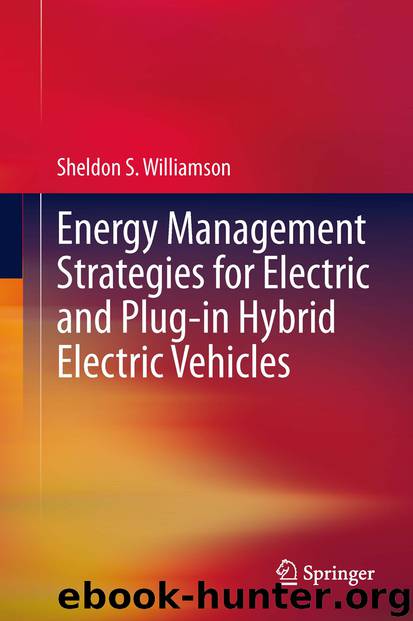Energy Management Strategies for Electric and Plug-in Hybrid Electric Vehicles by Sheldon S. Williamson

Author:Sheldon S. Williamson
Language: eng
Format: epub
Publisher: Springer New York, New York, NY
Fig. 6.27Efficiency versus transferred power on second cell: a Simulation novel EQ, b Simulation typ. EQ, and c Experimental Measurements Novel EQ
The “transferred power” is defined as the power provided to one or many cells, and the “total efficiency” is defined as the total equalizer losses over the transferred power from one or many cells (using the same components and switching frequency). Figures 6.26 and 6.27 summarize the efficiency versus transferred power for the simulations on several working points for both the typical and novel equalizers, as well as the experimental measurements on the novel prototype. Figure 6.26 shows the results with varying dt 1, thus generating power transfer mainly in the first cell, while Fig. 6.27 shows the results with varying dt 2, which creates power transfer mainly in the second cell.
From Fig. 6.26, it can be observed that the best performance is achieved by the novel cell equalizer. Figure 6.26 clearly indicates more than 80 % efficiency for a power transfer of 5–20 W (equivalent to 1.4–5.5 A). It must be noted that there exist only minor differences between the simulation and experimental measurements in this range of power transfer. The only important difference is at low transferred power (less than 3 W), whereby the efficiency falls under the specifications (approximately 60 %). As explained before, this is due to the idle consumption of about 1 W. This phenomenon was observed in the simulations as well as real measurements, due to the inductor current ripple flowing through the system.
In Fig. 6.27, there is a trivial difference in the performance, with the real measurements actually performing better than those predicted in the simulations. It presents the same worst-case performance (60 % efficiency) at low transfer power. Comparing all cases, the worst efficiency (68 %, at 20 W, and 55 %, at 25 W) is observed in the case of the typical cell equalizer, draining from the first cell. In fact, this result was predictable, since the current must traverse more equalizer units to flow from the first cell to the last cell, as shown in the configuration of Fig. 6.3. In general, the new equalizer performs better in extreme-to-extreme cell power transfers, contrary to the typical equalizer, which theoretically performs slightly better in adjacent cell power transfers.
Download
This site does not store any files on its server. We only index and link to content provided by other sites. Please contact the content providers to delete copyright contents if any and email us, we'll remove relevant links or contents immediately.
| Automotive | Engineering |
| Transportation |
Machine Learning at Scale with H2O by Gregory Keys | David Whiting(3987)
Never by Ken Follett(3716)
Urban Outlaw by Magnus Walker(3313)
OPNsense Beginner to Professional by Julio Cesar Bueno de Camargo(3230)
Sapiens and Homo Deus by Yuval Noah Harari(2951)
Will by Will Smith(2745)
A Short History of Nearly Everything by Bryson Bill(2585)
Hooked: A Dark, Contemporary Romance (Never After Series) by Emily McIntire(2470)
Rationality by Steven Pinker(2235)
Borders by unknow(2155)
Holy Bible (NIV) by Zondervan(2060)
The Becoming by Nora Roberts(2039)
The One Percenter Encyclopedia by Bill Hayes(1764)
Freedom by Sonny Barger(1747)
HBR's 10 Must Reads 2022 by Harvard Business Review(1744)
A Short History of War by Jeremy Black(1732)
Five Ways to Fall by K.A. Tucker(1668)
Girls Auto Clinic Glove Box Guide by Patrice Banks(1657)
Go Tell the Bees That I Am Gone by Diana Gabaldon(1655)
